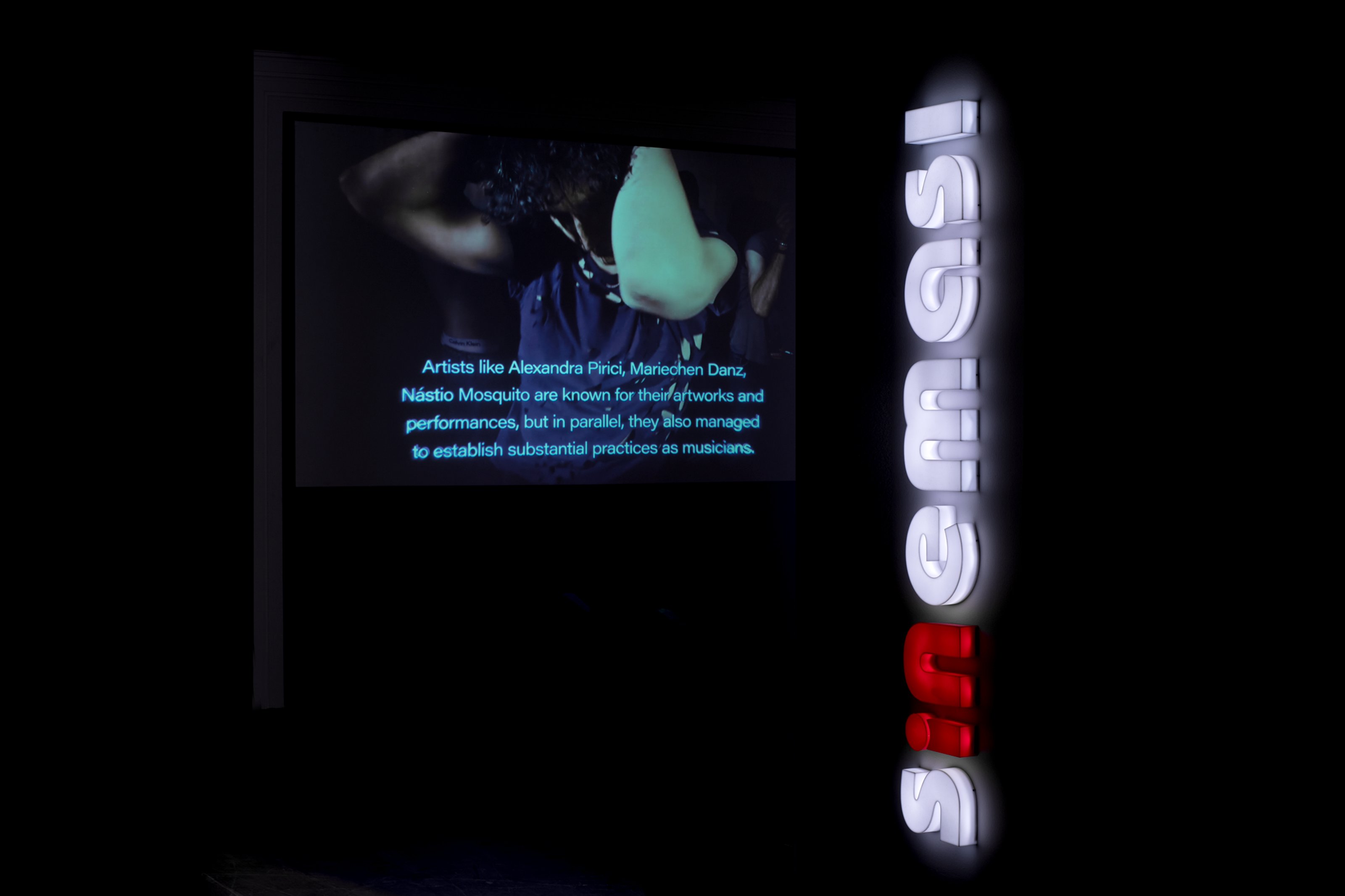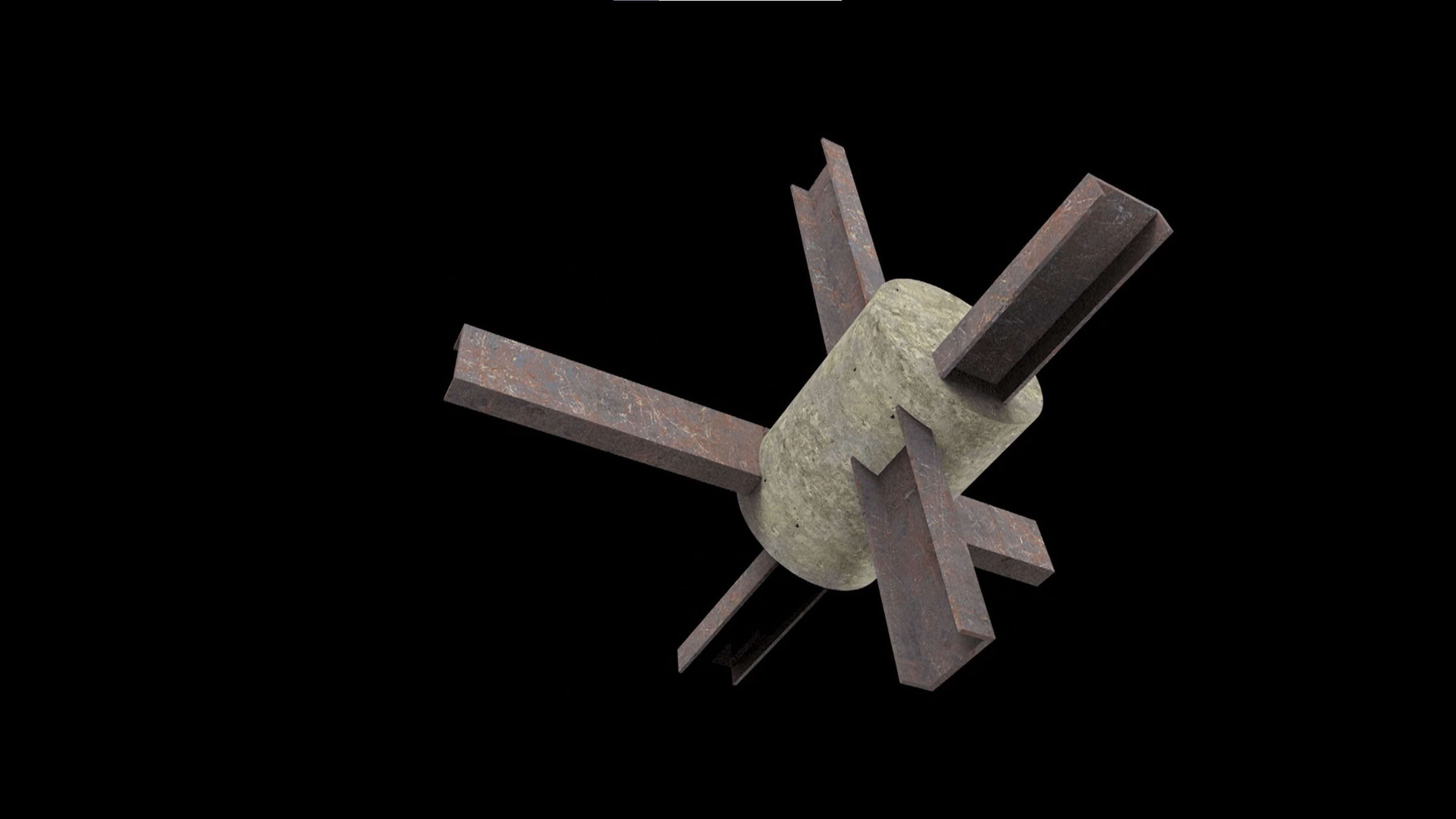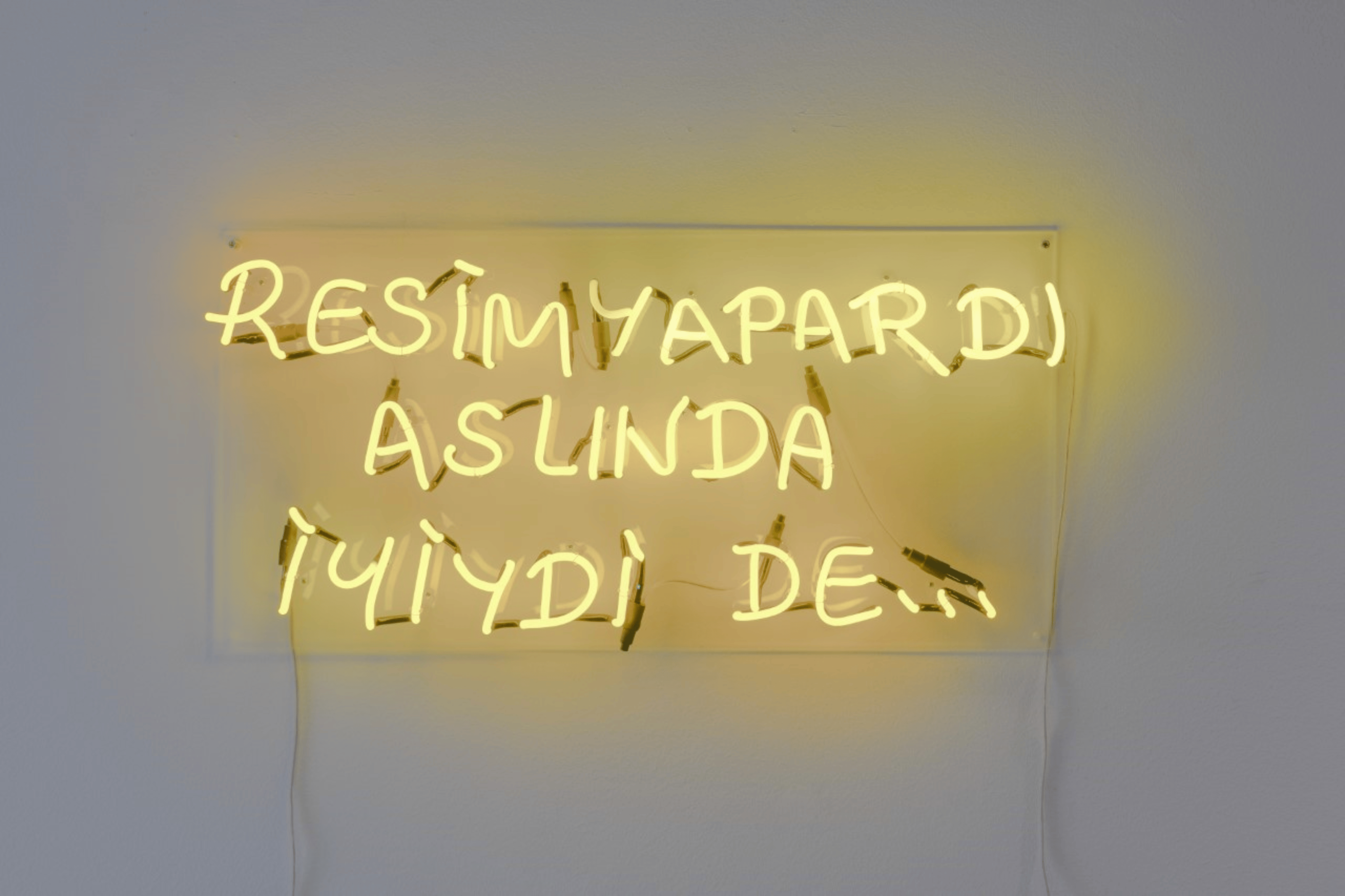Ahmet Öğüt’s practice is internationally recognized in the field of contemporary institutional critique. The artist approaches structural and ethical limits of the industry with progressive methodology that offers fresh analyses and alternatives to current systems. Through installations and participatory projects, Öğüt consistently brings pressing issues dealing with inequality, abuse of power, and bad practice in contemporary art to the forefront by offering platforms for discussion and the development of forward-thinking solutions.
In keeping with Collecteurs’ mission of developing ethical collecting practices and giving public access to the world’s unseen artworks, we are excited to launch this digital exhibition highlighting some of Öğüt’s recent projects. This exhibition precedes the upcoming project Cultural Value (forthcoming 2023) produced in collaboration between Collecteurs and Ahmet Öğüt.
In fall of 2022, Ahmet Öğüt’s solo exhibition at A:D curatorial in Berlin presented a series of projects in their space of which installation views are visible here. The large wall-text ABSOFUCKINGLUTELY (2022) dominated the space.

The term inserts the word “fucking” through the middle of “absolutely” to denote excitement and enthusiasm; one definition on Urban Dictionary claims that “absofuckinglutely” can be used to make a discussion or statement irrevocable. In the small letters above, this turns out to be an answer to the question: “can we change the system?” This double emphasis of word style and scale make typography a political and poetic statement that starts off the exhibition with a positive forward-thinking attitude that frames change as a necessary response to injustice.

The title of the A:D Curatorial exhibition in 2022 was inspired by the work Appointed Curators. This collage results from the titular Google Search when the work was made, which produced an array of curator’s portraits, many of them in a crossed-arm pose. This body language typically connotes being angry, closed-off, or uncomfortable. The collage humoristically portrays the inconsistencies in museum discourse which claims to be public and open but encounters endless struggles to find relevance among larger constituencies. Since the making of this artwork this portrait trend among curators has diminished, in one case a curator has even added a note underneath the photo saying “arms wide open.” The digital collage seeks to open up a discourse about power poses.

Ahmet Öğüt / Appointed Curators, 2022. 250cm x 200cm. Poster. Details of image search results of the words: “appointed curator”
Appointed Curators installation view. Photography by Davood Madadpoor.
Appointed Curators installation view. Photography by Davood Madadpoor.
The project Jump Up! (2022) is a collaborative and performative piece that turns the focus of the artworks onto the audience. Exhibitions are normally planned for the easy viewing of a hypothetical average viewer whose “average” height and physical ability is mirrored in the design and hang of the space.
In this work, Öğüt turns this around by installing three loaned works of art from existing collections high up near the ceiling. Viewing is facilitated by his placement of small trampolines beneath each work. This simple gesture makes the viewer into a performer but also comments on accessibility, and visibility of collections which are rarely on view. The collaborative aspect of this work repeats in Öğüt’s practice in which he borrows works from other artists and engages in a practice of “sampling” or highlighting works that engage with socially progressive ideas. Each installation requires the loan of three different artworks and this iteration features works by Julieta Aranda, VALIE EXPORT, and Boris Mikhailov loaned from the Neuer Berliner Kunstverein collection Artothek.

Ahmet Öğüt / Jump Up!, 2022, Installation.
Ahmet Öğüt / Jump Up!, 2022, Installation, with 3 selected works from the museum collection, 3 trampolines. Photo courtesy Museum of Contemporary Art Skopje.
Ahmet Öğüt’s recent films serve as an art historical and analytical function of new forms of art production. Reaching back to the 1980’s and 90’s to contemporaneous production and recent art theoretical publications, Artists Making Music (2021) embodies the collective and transdisciplinary approach which Öğüt proposes. By including the work of other artists such as Laibach, Nástio Mosquito, Cibelle Cavalli Bastos, and Isabel Lewis among others, the film itself engages with processes of collective practice through sampling to create a new work.

Ahmet Öğüt / Artists Making Music, 2021. Installation view.
Jörg Heiser’s hypothesis that context-shifting is a necessary reaction to social and economic contradictions within the art world is appropriately placed over a video of Alexandra Pirici - an artist who has managed to maintain autonomy from the world of galleries through this interdisciplinary combination that frees her of inherent political contradictions often found in the current art system. Öğüt’s films’ hypnotic scenes move through a multitude of musical genres and styles that follow one another to create a harmonic thesis. His proposal is that rather than a trend of the moment, interdisciplinarity is a necessary survival strategy that artists have always employed to break out of stereotypes and confines.
Ahmet Öğüt / Artists Making Music, 2021. Essay Documentary, 17’31’’.
Artworks Made at Home (2020) similarly uses the history of contemporary art to propose theory and contextualise broader movements. While the world was entering lockdowns in 2020, artists had to find creative ways to bypass the trip to the studio and work from home instead. Öğüt’s film highlights practices that have historically used the homeplace as a site of work, offering a contextualised history to the practice. Not all of the films are made fully in residential spaces: works such as Harun Farocki’s Einschlafgeschichten (Bedtime Stories) (1976-77) begin from children’s imaginative nightly bed-time stories. Other contributions such as Ulay’s theft of The Poor Poet (1839) by Carl Spitzweg begins in the Neue Nationalgalerie of Berlin, but ends as he hangs the work in the home of a lower-class guestworking family in Kreuzberg. The museum comes together with the home in the house-museum of Flo Kasearu, which uses the basement, attic, living space, and garden as a permanent site-specific installation that she also inhabits with her family.

Ahmet Öğüt / Artworks Made at Home, 2020. Installation view.
Ahmet Öğüt / Artworks Made at Home, 2020. Essay Documentary, 26’05’’.
In another digital project hosted by Institute of the Cosmos, Öğüt has collected a series of anecdotes about animals who have coexisted with museums. In the world’s major cities, these buildings have been erected to house art objects and provide spaces for the storage of collections and restoration - animals are de-facto excluded from these spaces. Despite this intended absence of other species from the confines of the museum, some animals have ventured within their doors or made homes around them.
For instance, I, the Kitten living around the Onomichi City Museum of Art (2022) relates the story of a small cat that has been trying to enter the museum through the front door. This inexplicable desire of the cat to enter the museum is related through a humorous sound piece in which the narrator explains that the cats had first heard about the museum through an exhibition about cats. The audio-work is accompanied by a 3D graphic of the animal that can serve as a digital monument to their efforts in a downloadable form. Other animals successfully inhabit museums such as a colony of bats at the National Museum of Cambodia, while others even work there such as the case of the Weimar Dog at the Museum of Fine Arts, Boston.

Photo courtesy of Twitter user @Bijutsu1.
Ahmet Öğüt / I, the Kitten living around Onomichi City Museum of Art, 2022. 00’42’’.
Is a video piece which shows a revolving image of an anti-tank barricade. This particular item was constructed in Ukraine in 1941 and was part of a Kyiv museum for several decades. With the outbreak of the war in 2022, the object was taken out of the museum and once again used as a practical defence in the city’s streets. This work questions what a museum object is and when its practical value shifts to a greater need than its historical one.


Still image: Ahmet Öğüt / Anti-tank Hedgehog, 2022. 03’31’’.
This satirical neon references an online remark made about Öğüt’s practice by an anonymous commentator on the web. Rather than making a statement about painting, the text refers to stereotypes and expectations of artists, especially in the context of Turkey, but which can be easily identified all over the world.

Ahmet Öğüt / Resim Yapardı Aslında İyiydi de
In a moment when monuments are a point of contention, the digital sphere can serve to re-imagine what they could become. In a collaboration with Artwrld - a platform that uses digital art on the blockchain to commission new works - Öğüt has created several augmented reality monuments that can be placed anywhere in the world by users with a smartphone. Using the traditional format of monuments - a tall plinth and a bust of the celebrated individual - his critique comes in his use of selection. Rather than national leaders, he has selected a group of whistleblowers whose work has exposed hazardous conditions or corruption from the USA to the Philippines.
Portrait busts of activists such as Marsha Coleman-Adebayo celebrate her courage in alerting to a mining company’s hazardous conditions for its workers in South Africa, or Li Wenliang - the medical doctor from China who first raised concerns about Covid and suffered political censorship for fulfilling his medical duty. There are also monuments to digital innovators such as Aaron Schwartz who developed multiple companies and technologies for free access to knowledge - his distribution of academic journals and philosophy of open information led him to court proceedings and his untimely death. The world of AR allows the audience to place these monuments equally in their own front yard or even within the boundaries of the very countries that silenced and prosecuted these activists.

Ahmet Öğüt / Monuments of the Disclosed, 2022.
Projects like Monuments of the Disclosed show Öğüt’s constant reinvention of art’s potential including through digital means. This one specifically allows participants to use AR as a covert game to counter censorship and corruption. This hands-on approach where the visitor is given autonomy to interact is visible across different projects like Jump Up! which effectively challenge the limitations of institutional spaces. His experimental forms of communication and presentation have created discussion, have gone viral, and have created meaningful impacts in the world.
Proceeds benefit the National Whistleblower Center and Protocinema.

Photography of Ahmet Öğüt by Albe Hamiti.
Ahmet Öğüt (b. 1981 in Diyarbakır) is a sociocultural initiator, artist, and lecturer. Working across a variety of media, including photography, video, and installation, Öğüt often uses humor and small gestures to offer his commentary on rather serious or pressing social and political issues. Öğüt regularly collaborates with people from outside of the art world to create shifts in common perceptions. He has exhibited internationally including recent solo presentations at MoCA Skopje – Museum of Contemporary Art, Kunstverein Dresden, Kunsthal Charlottenborg, Chisenhale Gallery, and Van Abbemuseum. He has also participated in numerous group exhibitions, including 17th Istanbul Biennial (2022); FRONT International - Cleveland Triennial for Contemporary Art (2022); Survival Kit 13 - Latvian Centre for Contemporary Art (2022); Asia Society Triennial: We Do Not Dream Alone (2021); In the Presence of Absence, Stedelijk Museum Amsterdam (2020); Zero Gravity at Nam SeMA, Seoul Museum of Art (2019); Echigo Tsumari Art Triennale (2018); the British Art Show 8 (2015-2017); 11th Gwangju Biennale (2016); the 13th Biennale de Lyon (2015); 19th Biennale of Sydney (2014); Performa 13, the Fifth Biennial of Visual Art Performance, New York (2013); the 7th Liverpool Biennial (2012); the 12th Istanbul Biennial (2011); the New Museum Triennial, New York (2009); and the 5th Berlin Biennial for Contemporary Art (2008).